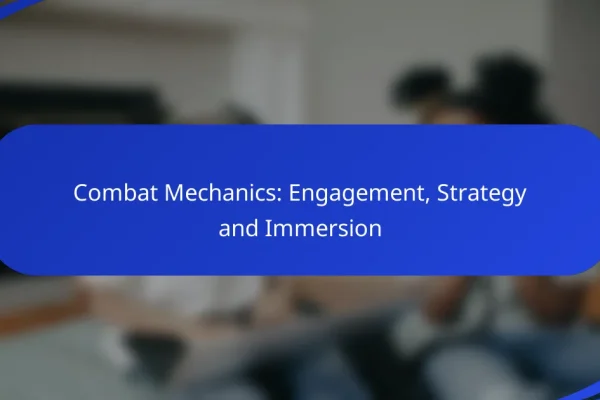What are the most effective game mechanics in violent video games?
The most effective game mechanics in violent video games include combat systems, reward structures, character progression, and environmental interactions. These elements enhance player engagement and satisfaction, driving the overall experience of violence in gameplay.
Combat systems
Combat systems are foundational in violent video games, determining how players engage with enemies. Effective systems often feature a mix of melee and ranged options, allowing for diverse strategies. For instance, games like “Doom” emphasize fast-paced shooting mechanics, while titles like “Dark Souls” focus on timing and precision in melee combat.
When designing combat systems, consider player feedback and responsiveness. A well-tuned system can create a satisfying experience, while poorly executed mechanics may frustrate players. Balancing difficulty is crucial; too easy may bore players, while too hard can lead to abandonment.
Reward structures
Reward structures in violent video games incentivize players to engage with the game mechanics. Common rewards include points, new weapons, or unlockable content that enhance gameplay. For example, “Grand Theft Auto V” offers monetary rewards for completing missions, which can be used to purchase upgrades.
To optimize reward structures, ensure they are meaningful and aligned with player goals. Consider implementing a tiered system where players receive incremental rewards, maintaining motivation throughout the game. Avoid making rewards too frequent, as this can diminish their perceived value.
Character progression
Character progression allows players to develop their avatars over time, enhancing the sense of investment in the game. This can include leveling up, acquiring new skills, or customizing abilities. Games like “Call of Duty” provide extensive customization options that cater to various play styles.
Effective character progression should offer players choices that impact gameplay. Allowing players to specialize in certain skills can create unique experiences. However, be cautious of over-complicating the system, as it may overwhelm new players.
Environmental interactions
Environmental interactions in violent video games enhance immersion and strategic gameplay. Players can often use the environment to their advantage, such as taking cover or triggering destructible elements. For instance, in “Battlefield,” players can destroy buildings to create new pathways or eliminate enemies.
To maximize environmental interactions, design levels that encourage exploration and creativity. Ensure that players can interact with various elements in meaningful ways. However, avoid making the environment too chaotic, as it can detract from the core gameplay experience.
How do violent video games influence player behavior?
Violent video games can significantly influence player behavior by altering emotional responses and social interactions. Research suggests that prolonged exposure to such games may lead to changes in how individuals perceive violence and react in real-life situations.
Desensitization effects
Desensitization refers to the process where repeated exposure to violent content reduces emotional responsiveness to violence. Players may become less shocked or disturbed by violent acts, both in games and in real life. This can lead to a normalization of aggressive behavior and a diminished emotional reaction to real-world violence.
For example, a player who frequently engages with graphic violence in games may find it harder to empathize with victims of real-life violence. This effect can manifest in decreased sensitivity to the suffering of others, impacting social relationships and moral judgments.
Empathy reduction
Empathy reduction occurs when individuals become less capable of understanding or sharing the feelings of others, often as a result of consuming violent media. Players immersed in violent scenarios may begin to view others more as objects rather than individuals with feelings. This shift can hinder interpersonal connections and reduce prosocial behaviors.
In practical terms, players might find it increasingly challenging to relate to friends or family members experiencing emotional distress. This can lead to strained relationships and a lack of support for those in need, as empathy plays a crucial role in social bonding.
Increased aggression
Increased aggression is a common concern associated with playing violent video games. Studies indicate that players may exhibit heightened levels of aggression, both in thought and behavior, after engaging with violent content. This can manifest in various ways, including verbal outbursts, physical altercations, or aggressive driving.
It’s important for players to be aware of their emotional state after gaming sessions. A simple self-check, such as reflecting on feelings of irritability or frustration, can help gauge the impact of gaming on behavior. Setting limits on playtime or choosing less violent games can be effective strategies to mitigate aggressive tendencies.
What are the ethical considerations of violent game mechanics?
Ethical considerations of violent game mechanics involve the potential impact on behavior, desensitization to violence, and the responsibility of developers. These factors raise questions about how violent content influences players, particularly younger audiences, and the moral obligations of the gaming industry.
Impact on youth
The impact of violent game mechanics on youth is a significant concern for parents and educators. Research suggests that exposure to violent video games may lead to increased aggression and desensitization to real-world violence among younger players. However, the effects can vary widely based on individual personality traits and environmental factors.
Parents should monitor the games their children play and consider age ratings as a guideline. Engaging in discussions about game content can help contextualize violent themes and encourage critical thinking about media consumption.
Regulatory frameworks
Regulatory frameworks for violent video games vary by country, with some nations implementing strict age ratings and content guidelines. In the United States, the Entertainment Software Rating Board (ESRB) provides ratings that inform consumers about game content, while other countries may have different systems, such as PEGI in Europe.
Understanding these frameworks is crucial for consumers and developers alike. Developers should ensure compliance with local regulations to avoid legal issues, while consumers should use these ratings to make informed choices about game purchases.
Industry accountability
Industry accountability in relation to violent game mechanics is increasingly under scrutiny. Developers are encouraged to consider the social implications of their content and to engage in responsible marketing practices. This includes being transparent about the nature of violence in their games and its potential effects on players.
Consumers can advocate for accountability by supporting companies that prioritize ethical practices and by voicing concerns about harmful content. Engaging in community discussions and providing feedback can influence industry standards and promote a healthier gaming environment.
How do different cultures perceive violent video games?
Cultural perceptions of violent video games vary significantly across the globe, influenced by social norms, historical contexts, and media consumption habits. While some cultures may accept these games as a form of entertainment, others may view them as harmful or inappropriate for certain age groups.
Regional acceptance
Acceptance of violent video games often depends on regional attitudes toward violence and media. For instance, countries like Japan and the United States generally have a higher tolerance for violent content in games, viewing them as a form of artistic expression. In contrast, many Middle Eastern countries may impose stricter views, often banning or censoring games that depict violence.
Content regulation
Content regulation of violent video games varies widely by region, with some countries implementing strict age ratings and content guidelines. For example, the Entertainment Software Rating Board (ESRB) in the U.S. assigns ratings to inform consumers about game content, while the Pan European Game Information (PEGI) system serves a similar purpose in Europe. In contrast, some countries may have no formal regulation, leading to a more laissez-faire approach to game distribution.
Market trends
Market trends indicate that violent video games continue to be popular, particularly in regions where they are culturally accepted. The global gaming market has seen a significant increase in sales of violent titles, with franchises like “Call of Duty” and “Grand Theft Auto” leading the way. However, in regions with stricter regulations, developers may focus on creating less violent content to cater to local preferences, impacting overall sales and market strategies.
What are the most popular violent video games and their mechanics?
The most popular violent video games often feature immersive mechanics that enhance gameplay and player engagement. Titles like the Call of Duty and Grand Theft Auto series exemplify how violence is integrated into game design, influencing player strategies and experiences.
Call of Duty series
The Call of Duty series is renowned for its fast-paced, first-person shooter mechanics that emphasize realism and tactical gameplay. Players engage in combat scenarios that often simulate military operations, utilizing a variety of weapons, equipment, and strategies to achieve objectives.
Key mechanics include multiplayer modes where players can compete in team-based or free-for-all matches, often featuring killstreak rewards that enhance gameplay. The series also incorporates a progression system, allowing players to unlock new weapons and abilities as they advance.
Grand Theft Auto series
The Grand Theft Auto series combines open-world exploration with violent gameplay elements, allowing players to engage in criminal activities within a detailed urban environment. Players can choose to follow the storyline or freely roam, committing acts of violence or completing missions.
Mechanics such as car theft, gunfights, and police chases create a dynamic experience. The game also features a moral choice system, where players’ actions can lead to different outcomes, influencing the narrative and character development.







